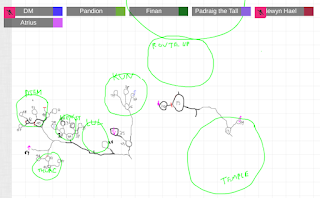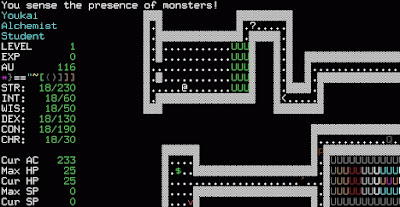A player in my regular online game posted some examples of my maps:
The one at the top is a zoomed-in combat map. The one at the bottom is level 2 of the megadungeon they're exploring.
Roll20 has all kind of fancy functions, but I'm too old now to be bothered how to learn. I would rather just scrawl things on the screen with the rudimentary drawing function. It does what it needs to. And it also, I think, spurs the players to use their imaginations rather than getting caught up in what they can see.
I never really thought of it this way before just now, but looking at these maps of mine with fresh eyes, it seems evident to me that my aesthetic experience of playing and running D&D is very strongly influenced by having wasted vast swathes of my teenage years playing *band games and other roguelikes, squinting at maps like this:
Shorn of box office visuals (or any visuals at all, really), the brain has to make up for it by doing a lot of imaginative legwork. This is the genius of ASCII-based roguelike games, of course: by providing an initially alienating aesthetic, they end up becoming more immersive than the most cutting edge PS5 offering, because you get caught up in a world that is as much, if not more, a product of your own imagination as the designer's. (The additional stimulation to the brain is also partly, I think, what makes them so addictive.)
The phenomenology of the visualisation of events in an RPG is fascinating to me. When a DM describes to four players a room in a dungeon, each of the five participants will build an image in his or her mind. Usually, this works tolerably well - well enough for everyone to have the same rough idea of where and what everything is. Yet we will never be able to tell how close their independent visualisations are to each other's, or to that of the DM. Every player in every RPG session ever played has created their own independent representation of a particular reality in their own mind, and it is one that can never fully be revealed to anybody but themselves. This is, you know, deep, man.



I couldn't agree more. I find "realistic" dungeon maps prevent me from doing any imagining. So although they are used with good intentions, the end result for me is a worse experience. I'm no stranger to a wargames table but when it comes to RPGs I will always use "theatre of the mind". That's where the magic happens.
ReplyDeleteHeh, glad you picked that up (and amazed how much my site visits go up whenever you post a link).
ReplyDeleteSlightly annoyed with myself for putting that post up first thing in the morning and conflating two very different things in it - I started off writing about how rewarding it is to draw maps, then remembered that I had these screenshots and my thoughts turned to basically what you're saying, which is that the theatre of the mind is more powerful than the horrible 3rd party combat maps that my other GM was so keen on.
I ran a dungeon once with a lot of verticality, sloping passages, rooms existing and exiting at different heights, etc. I would have found it hard to run without actual maps on my side due to those elements, but the player map ended up resembling an "electrical diagram". The circle-line (or node) map works just fine, provided it's not one of those annoying dungeons that wants you to find secret doors based on what's not mapped on graph paper.
ReplyDeleteYeah, I've moved increasingly towards circles and lines lately. It does the trick, and is just easier.
DeleteDo / how do y'all handle tracking of time during dungeon exploration with line-and-circle maps? Do you put distances on all of the lines and compute how many turns it takes the party to traverse them?
DeleteI generally go by rooms explored rather than strict movement rate per turn. 4 rooms for 12', 3 rooms for 9', etc. Intensive searching and combat also chew up time.
DeleteI often draw the circles and lines on graph paper so I can estimate distances. (Or on a grid on Roll20.) Otherwise I just do it by eye when on plain paper.
DeleteThis is probably why i have such fond memories of the old ZX Spectrum games, they were so visually barebones and I didn't even have the manuals of most of them so I filled huge gaps with whatever I came up with.
ReplyDeleteActually, we will - and over the ages have evolved methods to. :))
ReplyDeleteHowever, hastily drawn scrawls ARE good in that they are much closer to what actual party mapper would be able to do in the dungeon conditions than maps done by the DM and carefully compared to what's inside the book. We mainly used later than we played and now I see it as a big mistake. :(( Though honestly, it was mostly the turn from 1ed AD&D to 2ed that influenced us (1ed insisted on DM providing oral descriptions ONLY and one of the players being tasked with mapping... and it sometimes took too much time).
Later on, it were mainly Robin Laws' works that hinted that carefully drawn maps may actually detract from the game...
Mike
I have thought about experimenting with oral descriptions only but yeah, would take ages. It's so much more efficient if I just do it as the DM, though I recognise that results in missed opportunities for getting lost and other hilarity.
DeleteThat level 1 Alchemist is having a really bad day.
ReplyDeleteRPGs, of the tabletop or computer varieties,require a level of abstraction. TTRPGs by nature have this to some degree.A CRPG can have graphics and sound as nice as you like, but they need adumbration at best.